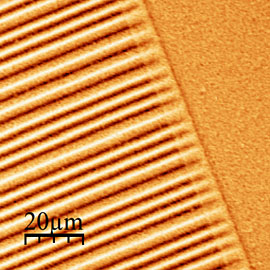Atomic Force Microscopy and Surface Characterisation
Schematic of the basic principle of an AFM
Atomic force microscopy (AFM) is nowadays widely used for the inspection of sample surfaces down to the atomic-scale. The experimental set-up of an AFM is based on a simple principle. It detects forces acting between a sample surface and a sharp tip that is mounted on a soft leaf spring (the so-called cantilever). The lateral resolution (x–y) depends on the radius of the tip which is between 10–20 nm. The vertical resolution (z) is typically better than 1 nm. Scanning of sample is possible in ambient conditions and liquids without elaborate sample preparation. Various modes and techniques available at IMT allow the analysis of surface roughness, hardness, frictional properties, magnetic properties, conductivity, in a wide temperature range (-30°C up to 200°C).
Persons interested in using AFM to their purposes are invited to write a proposal and apply for access with our user facility KNMFi.
| Magnetic signal measured on a 1.44 MB floppy disk. | Nanolithography on a PMMA substrate (approx. 5 nm in depth). |




